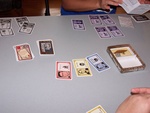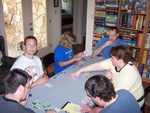
|
Family Business A game by David B. Bromley Published by Mayfair Games, Inc. Players: 2-6 Time: 30 minutes Reviewed by Susan Rozmiarek |

|
Family Business is a newly revised edition of an older title originally published by Mayfair in 1982. I do not have access to the older edition so I cannot really compare them. I do know that the art has been completely redone and that any rules changes are very minor. More info can be found at BoardgameGeek.com.
Family Business is a fast and furious card game with a mafia theme. Players lead a family of mobsters and try to eliminate rival mobsters while saving their own. The game falls firmly in the "beer and pretzels" category. This type of game can be very fun, but often have lots of luck and minimal strategy. If this kind of game does not appeal to you, stop reading now!
Components:
54 Mobster cards - these come in sets of six families with 9 mobsters in each, easily distinguished by differing background colors.
The families have different names like "Murder Inc., or "Capone Mob."
All the mobsters are individually named with a mugshot and are actual famous mobsters as far as I can tell.
I wish they had put a blurb of historical flavor text on each card. The back of each card depicts a grave.
58 Action cards - each of these has one of three different icons that indicate whether it is an Attack, Rescue, or Counter card. The art is cartoon-ish and rather humorous but nothing special. Unfortunately, there are many different types of cards and other than the name and icon; there is no information on the cards about how each works. The players constantly had to refer to the rules. There is a player's aid in the rules that one could reproduce for all the players as well as one on BoardgameGeek. I suppose one learns the cards with repeated play, but it would have been nice to have the information on the card as a reminder.
The cards are of good, heavy quality and come in a sturdy double-sized box with a lid.
The rules are black and white and fold out accordion style. They are fairly clear although a little hard to read because of the format.
Game play:
The goal of the game is to be the last player with mobsters still alive. Players each choose a family and place the 9 mobsters on the table in front of them. The Action cards are shuffled to form a deck and five cards are randomly dealt to each player as their starting hand. The box in placed in the center of the table. This is The Wall. During the game, mobsters will be targeted for elimination and lined up against The Wall for execution. Doesn't that sound nice!?
The dealer is the starting player and play will always go clockwise unless a Counter card is played. In this case, the player playing the Counter card goes next. A player's turn is very simple - they draw a card and then play or discard a card. Each played card has an effect that immediately takes place. It is, of course, all the various cards and their different effects that are the heart of the game. Here are the highlights and summary of each category of cards:
Attack cards
The main type of card is the Contract card. These are played on a particular player who then, depending on the type of contract, has to place one or two of their mobsters at the end of the Hit List. The Hit List is formed by adding mobsters in a line starting from The Wall. The first mobster in line is said to be "up against The Wall" and will be the first to be eliminated if a mob war starts. There is a priority contract that adds a mobster to the front of the Hit List. Contracts may be countered with Family Influence cards or Mob Power cards unless otherwise specified on the Contract card. Mob Power is especially nice because it reverses the Contract card and forces that player to put one of their mobsters on the Hit list.
Other Attack cards include ones that allow you to eliminate any mobster immediately, collect a mobster from each opponent and add them to the Hit List and start a mob war. Vendetta is a particularly nasty card because it allows the player to select two mobsters from each player to add to the Hit List and then a mob wars starts (more about this below). It can be countered with a Safehouse. My very favorite card is the St. Valentine's Day Massacre which immediately eliminates every mobster on the Hit List. Nasty! Fortunately, there is only one of these in the deck.
Rescue Cards
These cards save your mobsters in some way or, in the case of a Truce card, they stop a mob war. Various ways include removing a mobster from the Hit List (which is the only Rescue card that can be countered), swapping another mobster with one on the Hit List, or rearranging the order of the Hit List.
Counter Cards
The main rules with these cards is that only the first one played takes effect and the player who plays it takes his turn next. They are mostly used to counter Contracts.
Mob wars are how the majority of mobsters get eliminated and these can start in one of five ways:
- Playing a Mob War card
- Playing an Ambush card
- Playing a Vendetta card
- Having six or more mobsters on the Hit List
- Having six or fewer mobsters left in the game
When all of a player's mobsters are eliminated, he is out of the game. The winner is the last player with surviving mobsters.
Comments:
Family Business reminds me a little a lot of another light game, Guillotine, especially in the way each lines up characters to be eliminated each turn and the "draw a card, play a card" game play. In both games you are trying to manipulate the order of the line to get the results that you want. However, the similarity ends there. Guillotine is a set-collecting game where the executed characters do not belong to a particular player, unlike Family Business. I want to point it out though, because players who find Family Business to be a little too confrontational might enjoy the gentler game play of Guillotine.
I found the game to best with more players although it does take a little longer. It plays okay with fewer, but it is usually more lively and fun with a crowd.
The game play of Family Business is very mean and nasty. Players can ruthlessly gang up on one another so it is not going to be enjoyed by overly sensitive players. The only strategy in the game seems to be holding on to cards and playing them at the right time. A well-timed St. Valentine's Day Massacre can be quite deadly and satisfying to play! Obviously, this game is not going to be for everyone. It must be played in the right spirit with the right group of people. Players must accept that they are going to get relentlessly picked on and not get angry or hurt feelings. While I suppose it could be an icebreaker for a group of strangers, I feel that it is best played amongst friends, especially ones who are comfortable with adding a little roleplaying and fake accents for laughs. It provides a short and entertaining opening for a game night. With our group it is liable to start goodhearted (?) grudges that last throughout subsequent games. While I normally prefer games with more strategy, I was surprised at how much I enjoyed Family Business. It's quite a bit of fun for the right group and is one of the best games of its type that I've played.
| Other Web information: |
This page viewed
E-mail Ed Rozmiarek with questions or problems concerning this page.
Copyright © 2006, Ed & Susan Rozmiarek. No portion of this website may be reproduced or copied without the consent of Ed or Susan Rozmiarek.


